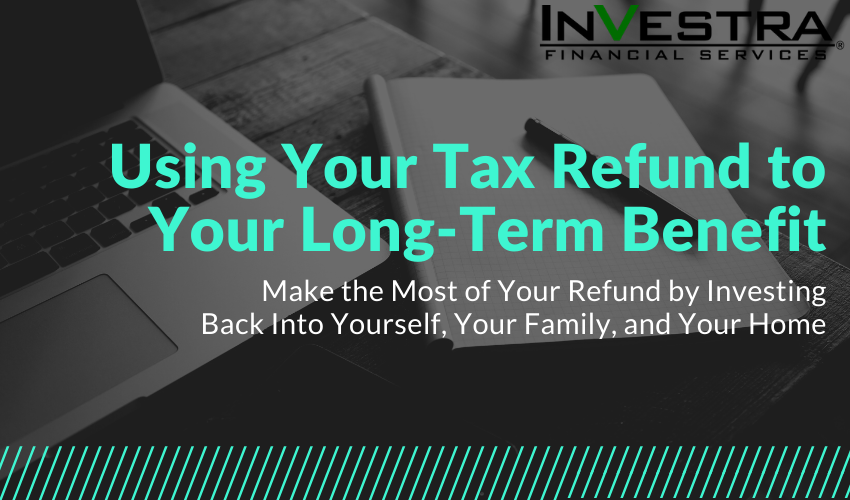It’s safe to say that most taxpayers agree that the process of tax filing can be tedious and complex, but the refund they receive makes it worth the effort. Every year, the IRS reports issuing over $300 billion in tax refunds, with the average individual receiving about $2500. According to the National Refund Federation survey, over a third of Americans reported that they planned to use their tax refund to pay down debt. Nearly 1 in 4 said that they would simply put it towards every day expenses, and only 13% said that they planned to spend it on a vacation. Ten percent said they would spend it on home improvements, and nine percent said they would “splurge” it. If you’re part of the majority of Americans who plan on receiving a tax refund this year intend to use it responsibly, you might be wondering just what financial objective takes priority.
Pay Off Debts
Everyone can agree that paying off debt is a wise way to use your tax refund – but not all debts are created equal. Although determining whether a debt is considered good or bad may depend on one’s own financial situation, we can generally differentiate between the two extremes. “Bad debt,” such as a high-interest credit card bills, involves borrowing money to purchase depreciating assets. In other words, if it doesn’t go up in value over time or have the potential to generate income, you shouldn’t go into debt to buy it. Wealth advisors recommend that you pay these debts down first. By applying that $2500 to your balance when you get your refund, you’ll save yourself thousands of dollars in interest in the long-term, and save you from incurring future interest charges. Even if you’re only able to pay off part of what you owe, the savings can be significant. Any other debt, such as money borrowed to pay for education or real estate (including home ownership), is considered ‘good’ because they are things that create long term value and thus are worth going into debt for. You can pay them off after you take care of your credit card.
Start an IRA
If you’re free of debt and have a solid amount of money in your savings account, professionals recommend saving for retirement as soon as possible. You’re probably familiar with the works of IRAs, but have you carefully considered the benefits of opening one for yourself? By acting now to save money using an IRA (Individual Retirement Account), you’re investing towards your savings goals and reducing your tax bill in retirement. There are two main types of IRAs: the traditional IRA and the Roth IRA. Both can be had in addition to a 401(k). Roth IRAs are set up where you pay taxes on the money going in so that future qualified withdraws are tax-free (unlike 401(k)s and traditional IRAs). This type of account is best for people who feel that their taxes are lower now than they will be during retirement, as opposed to that of a traditional IRA, in which contributions aren’t taxed but withdraws are. Depending on your eligibility, you may be even able to receive a deduction based on the amount you contribute each year. Once you open it, you can choose how to invest the money, whether it be in stocks, bonds, mutual funds, or EFTs and make contributions throughout the year as long as they don’t exceed your taxable compensation. Almost all banks, investment companies, and brokerage firms offer IRAs. Some offer no fees aside from commissions charged from buying and selling within the account, while some charge yearly management fees, so try to look for a no-fee account in order to keep costs to a minimum. If you’re not sure how to invest, consider seeking advice from an advisor; many are happy to charge you a one-time fee. The bottom line: whether it’s a traditional or Roth IRA, get started as soon as possible! That $2500 that would otherwise be going towards a “splurge” or even sitting in your savings account could be working hard for you in an IRA.
Make Home Improvements
If you’re like most Americans, you consider your home your most valuable asset, so it’s important to realize that sometimes even small upgrades can significantly increase the value of your home (or prevent it from depreciating down the line). Take a look at what needs to be updated ASAP before you consider what could potentially be done to improve your quality of life. Keep in mind many improvements don’t have to cost an arm and a leg; here are some ideas you can use to get started, ranging from least expensive to most:
- Get your HVAC system reserviced. Experts recommend getting your HVAC system checked by a professional once a year for a standard central AC or furnace, and twice a year if you have a heat pump system. Regularly maintaining your unit can save you money in the long run by reducing utility bills, preventing breakdowns, and extending the life of the unit. These maintenance costs range from only $75-$125.
- Seal your driveway. By regularly sealing your concrete driveway annually, or at least every few years, you can enhance your home’s curb appeal while adding to the life of your driveway for an average of $0.14 to $0.25 per square foot. By sealing it you prevent water, sunlight and harsh air from permeating into the concrete and damaging it. Most quality sealants also repel oil and leaks, making clean up much easier than that of a driveway that would otherwise absorb spills.
- Add some greenery to your landscape. One sure way to increase the resale value of your home is to maintain good landscaping. Keep your lawn green by aerating it often, using natural fertilizers, and watering it deeply and less often. Refresh mulch around plant beds for an average of $30 to $60 per yard. Trim down your electric and energy bills by strategically planting trees and shrubs to provide shade for outdoor air conditioning units. You might also consider adding outdoor lighting that shows off your landscaping while adding to the overall value of your home.
- Make your garage door like new. Instead of replacing your garage door for a fortune, paint it for under $300! Many homeowners also opt to embellish their garage doors with decorative hardware such as faux hinges and handles to increase curb appeal.
- Refresh the paint on the interior of your home. Over time, the paint on our walls can start to look dingy. If you’ve never refreshed the paint inside your home, consider transforming your old space into a fresh, new feel by touching up or repainting your interior entirely for around $350 per average-sized room. Sean Juneja, founder of interior design firm Décor Aid, recommends painting with soft neutrals in order to appeal to a mass market; avoid anything too flashy or dramatic.
- Install a ceiling fan. If you don’t already have standard ceiling fans in throughout your house, consider making installations for an average of cost of $245 each, according to HomeAdvisor. This increases the value of your home while improving airflow and enhancing your comfort.
- Insulate your attic. Full attic insulation can cost between $1700 and $2100 depending on what material you use, but is worth it in the long run by preventing gradual damage to your home and preventing elements outside from seeping in. According to a study by Senica Air, the average home can save more than 10% on cooling costs by insulating the attic.
- Hire professional cleaners. Invest in your home by hiring a professional cleaning service to extend the lifespan of your home. It’s important to give attention to protect things like wood flooring, carpets, and fixtures in special ways that can easily be overlooked by average daily cleaning efforts. Outsourcing this task can sometimes be more cost effective than doing it yourself because cleaning supplies can get expensive, and agencies are certified to use stronger cleaning solutions that aren’t available to the public.
- Upgrade your space by adding tile to any high–traffic areas of your home. Tiles are exceptionally durable and require hardly any maintenance aside from routine cleaning, unlike carpets and hardwood flooring. They’re flame resistant, scratch resistant, mild resistant, and don’t become easily damaged by water, making them an easy option for modern homeowners.
- Install granite kitchen countertops. New countertops, specifically granite, can add value to your property by having a mass appeal due to their timeless nature and durability. They offer a high return on investment; a general rule of thumb is that new countertops will increase your home’s value by around 3 times the value of what you have installed. Nowadays granite is even so popular that most homebuyers consider it a “must have.” Choose stones with natural earth tones like white, black, and brown to appeal best to the market.
If you don’t have a house, keep these things in mind and consider saving your refund for an eventual down payment.
Invest in Yourself
If you’re already out of debt and find yourself to be on track for retirement, think about investing in yourself, because your assets don’t end with a valuable home and money in the stock market. Investing in your personal, professional, and financial growth not only directly impacts your current quality of life, but will yield returns well into the future. It’s important to first gain clarity about the goals you want to achieve, and be intentional about what you’re doing to try to get there. Many professionals find it helpful to seek the assistance of mentors and coaches such as personal trainers, relationship counselors, and financial advisors to help define those goals and outline the step by step actions they need to take depending on the areas of their lives they’re most keen on improving. Start thinking about what interests you. What makes you passionate? What have you always wanted to learn about, but just haven’t gotten around to? What would help you grow in your personal life and career? You don’t have to focus solely on new skills; think about what already makes you unique and how you could build on it. Brainstorm with a pen and paper and commit to learning something definite by the end of the month or quarter. It’s important to remember that education doesn’t end with a college degree or certificate. Consider taking online courses and workshops, attending conferences, and joining networking groups in order to capitalize on free knowledge. Nowadays, the internet is our best friend when it comes to advancing ourselves through informal education such as attending virtual scholarly courses and webinars, attainting certifications, and subscribing to relevant publications by experts. Another way to invest in yourself is to expand your network; whether you’re attending educational events in person or online, learning new skills at workshops, or just meeting people informally while you’re out and about, you’ll benefit from spending time with like-minded individuals. When traveling isn’t an option, consider using online forums such as industry-specific Facebook groups, LinkedIn, Reddit, and Meetup.com to maximize these opportunities.
Content in this material is for general information only and not intended to provide specific advice or recommendations for any individual. All investing involves risk including loss of principal.
A Roth IRA offers tax deferral on any earnings in the account. Qualified withdrawals of earnings from the account are tax-free. Withdrawals of earnings prior to age 59 ½ or prior to the account being opened for 5 years, whichever is later, may result in a 10% IRS penalty tax. Limitations and restrictions may apply.
LPL Tracking: 1-05105478






